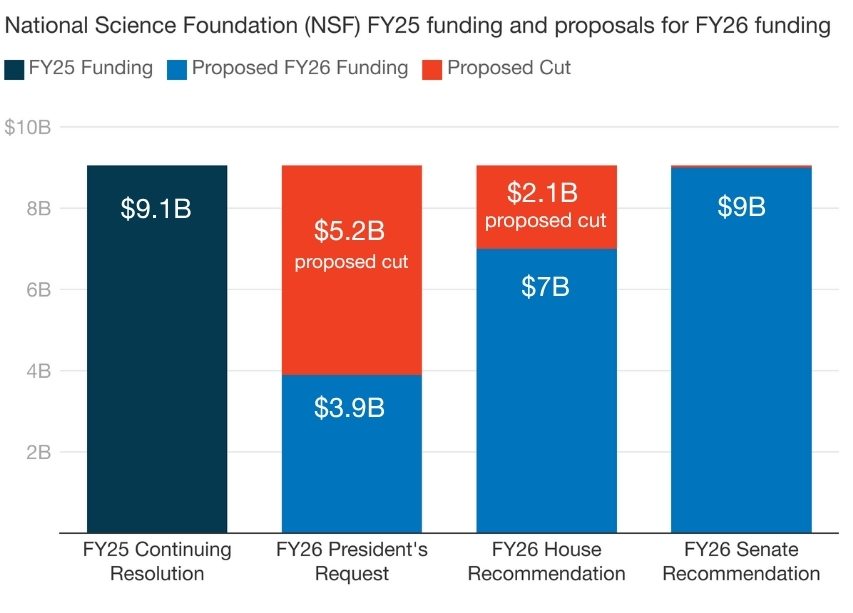The Association of American Universities (AAU) urges Congress to fund the National Science Foundation (NSF) at $9 billion for FY26, the funding level approved by the U.S. Senate Committee on Appropriations in July. Funding the NSF at this level will enable the United States to maintain and strengthen our global leadership in scientific innovation.

NSF-powered science built modern America
For 75 years, the NSF has been a leading source of federal funding for science and engineering research. The agency is unique because of its commitment to supporting basic, curiosity-driven science that generates new knowledge. NSF-funded research has led to advances in artificial intelligence, cybersecurity, MRI technology, gene editing, and 3D printing − innovations that have led to better health and greater prosperity and security for all Americans.
- Neural networks to AI: Fifty years ago, NSF invested in basic research on artificial neural networks and stochastic modeling. Decades later, these investments have led to an explosion of AI-powered tools that are being used for drug development, weather forecasting, financial modeling, supply chain optimization, cybersecurity, and intelligence gathering.
- Launching the biotech industry: In the 1960s, NSF supported biologists who identified bacteria that can thrive at very high temperatures. This discovery enabled the development of polymerase chain reaction (PCR) technology, which led to breakthroughs in genetic testing and disease diagnosis and helped launch the multibillion-dollar biotechnology industry.
- Advanced Manufacturing Research: NSF has played a critical role in the development of additive and advanced manufacturing by funding research on materials science, mechanical engineering, and computational workflows. NSF-supported research has strengthened domestic manufacturing and supply chains while adding billions to the U.S. economy.
NSF drives entrepreneurship, a skilled workforce, and economic growth
Since its founding, NSF has invested billions into developing the nation’s scientific workforce and in cultivating innovation-based research in all 50 states . NSF’s investments have supported entrepreneurship and the commercialization of university-based science, bringing new solutions to market and creating jobs, businesses, and economic growth in the process.
- The NSF’s Graduate Research Fellowship Program has helped educate and train more than 75,000 early-career STEM researchers , including 50 Nobel laureates.
- The NSF Engines program supports innovation ecosystems aimed at solving economic challenges in states and regions – the Midwest, the South, and rural areas – that have not fully participated in the tech boom in computing and AI.
- America’s Seed Fund provides early-stage capital to tech start-ups that seek to commercialize university-based research through the congressionally mandated Small Business Innovation Research (SBIR) and Small Business Technology Transfer (STTR) programs. America’s Seed Fund has supported the creation of 400 companies across 31 technology sector.
- Engineering Research Centers are university-based, interdisciplinary research centers that pursue high-risk, high-payoff research in advanced manufacturing, biotechnology, clean energy, microelectronics, and information technology. NSF has funded 83 ERCs, leading to 250 spinoff companies, 920 patents , 1,400 invention licenses, and nearly 15,000 undergraduate and graduate degrees .
- Industry-University Cooperative Research Centers catalyze research through close and sustained engagement between university researchers and industry innovators. IUCRCs focus on applied research areas that are of strategic interest to industry, including advanced electronics, advanced manufacturing, biotech, civil infrastructure, health and safety, and sensing and information systems.
NSF is essential to global competitiveness
The NSF devotes significant resources to research on emerging technologies such as AI, quantum and future computing, and robotics into which China is making large-scale public investments. China's research and development expenditures have grown more than twice as fast as America’s and will likely outpace ours in the future. Federal funding is critical for keeping America ahead in these sectors.
- NSF spends $700 million annually to support the next generation of AI researchers and build essential AI research infrastructure. Two major initiatives include the National Artificial Intelligence Research Resource Pilot and the National AI Research Institutes, a network of 29 institutes located at major American universities that partner with regional universities, businesses, and civil society groups across the nation.
- NSF has invested at least $350 million in basic quantum research, workforce training, and facilities for testing quantum devices and materials. Quantum Leap Challenge Institutes and the National Quantum Virtual Laboratory are partnerships between NSF, universities research labs, and private partners to develop quantum-based technologies for practical applications.